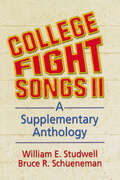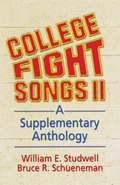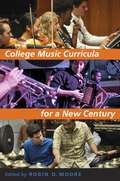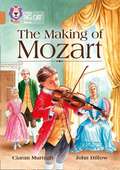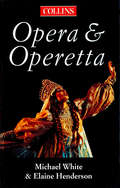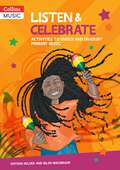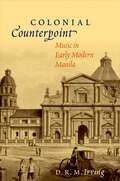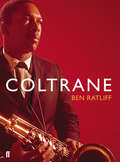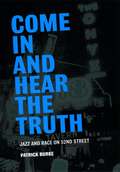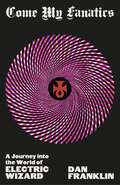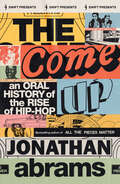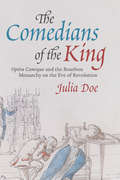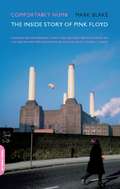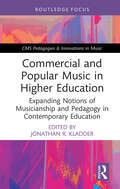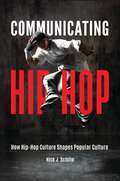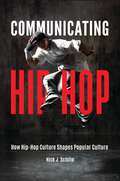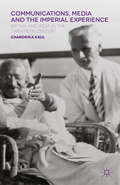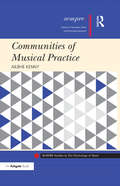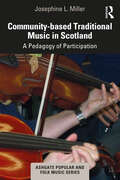- Table View
- List View
College Fight Songs II: A Supplementary Anthology
by William E Studwell Bruce R SchuenemanCome join the band! College Fight Songs II is a supplement to the original College Fight Songs, providing 97 additional song texts and interesting historical information. Together they are a unique anthology of college fight songs from across the country.College Fight Songs II: A Supplementary Anthology is a second-round knockout that finishes the job started by the first edition. This rollicking continuation of the original collection will give you even more to shout about, again bringing together complete lyrics, historical annotations, and musical scores of the songs of over 50 more colleges and universities!Full of spirited music and lyrics that will put a spring in the step of incoming freshmen and music historians alike, College Fight Songs II is for you! You'll uncover plenty of behind-the-scenes info about the songs and the people who inspired them, and of course you'll find: complete musical scores full lyrics basic historical background concerning the songs and their institutions information regarding the songwriters and college nicknamesSo let&’s “Hail West Virginia,” stay “Ever True to Brown,” “Fight for LSU,” and shout out “The Buckeye Battle Cry!” College Fight Songs II will keep you in the game!
College Fight Songs II: A Supplementary Anthology
by William E Studwell Bruce R SchuenemanCome join the band! College Fight Songs II is a supplement to the original College Fight Songs, providing 97 additional song texts and interesting historical information. Together they are a unique anthology of college fight songs from across the country.College Fight Songs II: A Supplementary Anthology is a second-round knockout that finishes the job started by the first edition. This rollicking continuation of the original collection will give you even more to shout about, again bringing together complete lyrics, historical annotations, and musical scores of the songs of over 50 more colleges and universities!Full of spirited music and lyrics that will put a spring in the step of incoming freshmen and music historians alike, College Fight Songs II is for you! You'll uncover plenty of behind-the-scenes info about the songs and the people who inspired them, and of course you'll find: complete musical scores full lyrics basic historical background concerning the songs and their institutions information regarding the songwriters and college nicknamesSo let&’s “Hail West Virginia,” stay “Ever True to Brown,” “Fight for LSU,” and shout out “The Buckeye Battle Cry!” College Fight Songs II will keep you in the game!
College Music Curricula for a New Century
Critiques and calls for reform have existed for decades within music education, but few publications have offered concrete suggestions as to how things might be done differently. Motivated by a desire to do just that, College Music Curricula for a New Century considers what a more inclusive, dynamic, and socially engaged curriculum of musical study might look like in universities. Editor Robin Moore creates a dialogue among faculty, administrators, and students about what the future of college music instruction should be and how teachers, institutions, and organizations can transition to new paradigms. Including contributions from leading figures in ethnomusicology, music education, theory/composition, professional performance, and administration, College Music Curricula for a New Century addresses college-level curriculum reform, focusing primarily on performance and music education degrees, and offer ideas and examples for a more inclusive, dynamic, and socially engaged curriculum of applied musical study. This book will appeal to thoughtful faculty looking for direction on how to enact reform, to graduate students with investment in shaping future music curricula, and to administrators who know change is on the horizon and seek wisdom and practical advice for implementing change. College Music Curricula for a New Century reaches far beyond any musical subdiscipline and addresses issues pertinent to all areas of music study.
COLLEGE MUSIC CURRICULA FOR A NEW CENT C
by Robin D. MooreCritiques and calls for reform have existed for decades within music education, but few publications have offered concrete suggestions as to how things might be done differently. Motivated by a desire to do just that, College Music Curricula for a New Century considers what a more inclusive, dynamic, and socially engaged curriculum of musical study might look like in universities. Editor Robin Moore creates a dialogue among faculty, administrators, and students about what the future of college music instruction should be and how teachers, institutions, and organizations can transition to new paradigms. Including contributions from leading figures in ethnomusicology, music education, theory/composition, professional performance, and administration, College Music Curricula for a New Century addresses college-level curriculum reform, focusing primarily on performance and music education degrees, and offer ideas and examples for a more inclusive, dynamic, and socially engaged curriculum of applied musical study. This book will appeal to thoughtful faculty looking for direction on how to enact reform, to graduate students with investment in shaping future music curricula, and to administrators who know change is on the horizon and seek wisdom and practical advice for implementing change. College Music Curricula for a New Century reaches far beyond any musical subdiscipline and addresses issues pertinent to all areas of music study.
Collins Big Cat, Band 12, Copper: The Making of Mozart (PDF)
by Ciaran Murtagh Collins Big Cat StaffGet ready to meet a small boy with a big talent! Wolfgang Amadeus Mozart was composing music and travelling the world to perform for kings and emperors when he was only eight years old. This is his story. * Copper/Band 12 books provide more complex plots and longer chapters that develop reading stamina. * Text type - An information book. * The book is organised into short chapters to help children practise the skills of locating and identifying important information. * The glossary and index on pages 28 and 29 can be used to develop children's information retrieval skills further. * Curriculum links - Music
The Collins Guide To Opera And Operetta
by Michael White Elaine HendersonOriginally published in 1997, Collins Opera & Operetta is an invaluable guide to this fascinating but sometimes misunderstood art form, presenting essential information on over 180 major operas and operettas in an accessible, yet scholarly, way.
Collins Primary Music Listen And Celebrate: Activities To Enrich And Diversify Primary Music
by Nathan Holder Helen MacGregor Charity RussellListen and celebrate introduces a selection of 15 pieces from a range of time periods, countries and styles, celebrating the people who wrote the music and offering an immersive experience through active listening and composing activities. As well as supporting National Curriculum objectives for Key Stages 1 and 2, this book will help bring breadth and depth to children's musical experience and understanding, offering a glimpse of the huge variety of music in the world and featuring composers from a range of backgrounds and experiences.
Colonial Counterpoint: Music in Early Modern Manila (Currents in Latin American and Iberian Music)
by D. R. IrvingNamed one of BBC History Magazine's "Books of the Year" in 2010 In this groundbreaking study, D. R. M. Irving reconnects the Philippines to current musicological discourse on the early modern Hispanic world. For some two and a half centuries, the Philippine Islands were firmly interlinked to Latin America and Spain through transoceanic relationships of politics, religion, trade, and culture. The city of Manila, founded in 1571, represented a vital intercultural nexus and a significant conduit for the regional diffusion of Western music. Within its ethnically diverse society, imported and local musics played a crucial role in the establishment of ecclesiastical hierarchies in the Philippines and in propelling the work of Roman Catholic missionaries in neighboring territories. Manila's religious institutions resounded with sumptuous vocal and instrumental performances, while an annual calendar of festivities brought together many musical traditions of the indigenous and immigrant populations in complex forms of artistic interaction and opposition. Multiple styles and genres coexisted according to strict regulations enforced by state and ecclesiastical authorities, and Irving uses the metaphors of European counterpoint and enharmony to critique musical practices within the colonial milieu. He argues that the introduction and institutionalization of counterpoint acted as a powerful agent of colonialism throughout the Philippine Archipelago, and that contrapuntal structures were reflected in the social and cultural reorganization of Filipino communities under Spanish rule. He also contends that the active appropriation of music and dance by the indigenous population constituted a significant contribution to the process of hispanization. Sustained "enharmonic engagement" between Filipinos and Spaniards led to the synthesis of hybrid, syncretic genres and the emergence of performance styles that could contest and subvert hegemony. Throwing new light on a virtually unknown area of music history, this book contributes to current understanding of the globalization of music, and repositions the Philippines at the frontiers of research into early modern intercultural exchange.
Colonial Counterpoint: Music in Early Modern Manila (Currents in Latin American and Iberian Music)
by D. R. IrvingNamed one of BBC History Magazine's "Books of the Year" in 2010 In this groundbreaking study, D. R. M. Irving reconnects the Philippines to current musicological discourse on the early modern Hispanic world. For some two and a half centuries, the Philippine Islands were firmly interlinked to Latin America and Spain through transoceanic relationships of politics, religion, trade, and culture. The city of Manila, founded in 1571, represented a vital intercultural nexus and a significant conduit for the regional diffusion of Western music. Within its ethnically diverse society, imported and local musics played a crucial role in the establishment of ecclesiastical hierarchies in the Philippines and in propelling the work of Roman Catholic missionaries in neighboring territories. Manila's religious institutions resounded with sumptuous vocal and instrumental performances, while an annual calendar of festivities brought together many musical traditions of the indigenous and immigrant populations in complex forms of artistic interaction and opposition. Multiple styles and genres coexisted according to strict regulations enforced by state and ecclesiastical authorities, and Irving uses the metaphors of European counterpoint and enharmony to critique musical practices within the colonial milieu. He argues that the introduction and institutionalization of counterpoint acted as a powerful agent of colonialism throughout the Philippine Archipelago, and that contrapuntal structures were reflected in the social and cultural reorganization of Filipino communities under Spanish rule. He also contends that the active appropriation of music and dance by the indigenous population constituted a significant contribution to the process of hispanization. Sustained "enharmonic engagement" between Filipinos and Spaniards led to the synthesis of hybrid, syncretic genres and the emergence of performance styles that could contest and subvert hegemony. Throwing new light on a virtually unknown area of music history, this book contributes to current understanding of the globalization of music, and repositions the Philippines at the frontiers of research into early modern intercultural exchange.
Coltrane: The Story of a Sound
by Ben RatliffNo other jazz musician has proved so inspirational and so fascinating as Coltrane. Ben Ratliff, jazz critic for the New York Times, has written the first book to do justice to this great and controversial music pioneer. As well as an elegant narrative of Coltrane's life Ratliff does something incredibly valuable - he writes about the saxophonist's unique sound.
Come In and Hear the Truth: Jazz and Race on 52nd Street
by Patrick BurkeBetween the mid-1930s and the late ’40s, the center of the jazz world was a two-block stretch of 52nd Street in Manhattan. Dozens of crowded basement clubs between Fifth and Seventh avenues played host to legends such as Billie Holiday and Charlie Parker, as well as to innumerable professional musicians whose names aren’t quite so well known. Together, these musicians and their audiences defied the traditional border between serious art and commercial entertainment—and between the races, as 52nd Street was home to some of the first nightclubs in New York to allow racially integrated bands and audiences. Patrick Burke argues that the jazz played on 52nd Street complicated simplistic distinctions between musical styles such as Dixieland, swing, and bebop. And since these styles were defined along racial lines, the music was itself a powerful challenge to racist ideology. Come In and Hear the Truth uses a range of materials, from classic photographs to original interviews with musicians, to bring the street’s vibrant history to life and to shed new light on the interracial contacts and collaborations it generated.
Come My Fanatics: A Journey into the World of Electric Wizard
by Dan Franklin'Electric Wizard is heavy, man - we don't sing about love and flowers.' Jus ObornIn 1993, in the market town of Wimborne Minster in Dorset, England, the heaviest band in the world was born. Led by guitarist and singer Jus Oborn, Electric Wizard began as an untameable power trio. They inhaled the iniquity of their lives and vomited it out in colossal waves of doom metal, synthesising the forbidding local landscape, biker culture, video-nasties, black magic rituals and titanic doses of psychedelics. In 1997 they released their revolutionary second album, Come My Fanatics... Then, after triumphant and calamitous tours of the USA and following the release of arguably the heaviest rock album ever recorded, 2000's Dopethrone, Electric Wizard all but imploded, destroyed by the very reality they were fighting against. However, when guitarist Liz Buckingham joined Oborn on guitar for We Live, they drew a magic circle around themselves in a new line-up that went on to explore deeper occult horrors on modern doom classic Witchcult Today onwards. Come My Fanatics is a kaleidoscopic exploration of the subculture the band has absorbed and, in turn, created. From seventies exploitation cinema, through the writers of Weird Tales magazine and a panoply of the marginal and downright sinister, to the band's own live ceremonial happenings - this is Electric Wizard's world. We're just dying in it.
The Come Up: An Oral History of the Rise of Hip-Hop
by Jonathan AbramsThe music that would come to be known as hip-hop was born at a party in the Bronx in the summer of 1973. Now, fifty years later, it’s the most popular music genre in America. Just as jazz did in the first half of the twentieth century, hip-hop and its groundbreaking DJs and artists—nearly all of them people of colour from some of America’s most overlooked communities—pushed the boundaries of music to new frontiers, while transfixing the country’s youth and reshaping fashion, art, and even language. And yet, the stories of many hip-hop pioneers and their individual contributions in the pre-Internet days of mixtapes and word of mouth are rarely heard—and some are at risk of being lost forever. Now, in The Come Up, the New York Times bestselling author Jonathan Abrams offers the most comprehensive account so far of hip-hop’s rise, a multi-decade chronicle told in the voices of the people who made it happen. In more than three hundred interviews conducted over three years, Abrams has captured the stories of the DJs, executives, producers, and artists who both witnessed and themselves forged the history of hip-hop. Masterfully combining these voices into a seamless symphonic narrative, Abrams traces how the genre grew out of the resourcefulness of a neglected population in the South Bronx, and from there how it flowed into New York City’s other boroughs, and beyond—from electrifying live gatherings, then on to radio and vinyl, below to the Mason-Dixon Line, west to Los Angeles through gangster rap and G-funk, and then across generations. Abrams has on record Grandmaster Caz detailing hip-hop’s infancy, Edward “Duke Bootee” Fletcher describing the origins of “The Message,” DMC narrating his role in introducing hip-hop to the mainstream, Ice Cube recounting N.W.A’s breakthrough and breakup, Kool Moe Dee recalling his Grammys boycott, and countless more key players. Throughout, Abrams conveys with singular vividness the drive, the stakes, and the relentless creativity that ignited one of the greatest revolutions in modern music. The Come Up is an exhilarating behind-the-scenes account of how hip-hop came to rule the world—and an essential contribution to music history.
The Comedians of the King: "Opéra Comique" and the Bourbon Monarchy on the Eve of Revolution
by Julia DoeLyric theater in ancien régime France was an eminently political art, tied to the demands of court spectacle. This was true not only of tragic opera (tragédie lyrique) but also its comic counterpart, opéra comique, a form tracing its roots to the seasonal trade fairs of Paris. While historians have long privileged the genre’s popular origins, opéra comique was brought under the protection of the French crown in 1762, thus consolidating a new venue where national music might be debated and defined. In The Comedians of the King, Julia Doe traces the impact of Bourbon patronage on the development of opéra comique in the turbulent prerevolutionary years. Drawing on both musical and archival evidence, the book presents the history of this understudied genre and unpacks the material structures that supported its rapid evolution at the royally sponsored Comédie-Italienne. Doe demonstrates how comic theater was exploited in, and worked against, the monarchy’s carefully cultivated public image—a negotiation that became especially fraught after the accession of the music-loving queen, Marie Antoinette. The Comedians of the King examines the aesthetic and political tensions that arose when a genre with popular foundations was folded into the Bourbon propaganda machine, and when a group of actors trained at the Parisian fairs became official representatives of the sovereign, or comédiens ordinaires du roi.
The Comedians of the King: "Opéra Comique" and the Bourbon Monarchy on the Eve of Revolution
by Julia DoeLyric theater in ancien régime France was an eminently political art, tied to the demands of court spectacle. This was true not only of tragic opera (tragédie lyrique) but also its comic counterpart, opéra comique, a form tracing its roots to the seasonal trade fairs of Paris. While historians have long privileged the genre’s popular origins, opéra comique was brought under the protection of the French crown in 1762, thus consolidating a new venue where national music might be debated and defined. In The Comedians of the King, Julia Doe traces the impact of Bourbon patronage on the development of opéra comique in the turbulent prerevolutionary years. Drawing on both musical and archival evidence, the book presents the history of this understudied genre and unpacks the material structures that supported its rapid evolution at the royally sponsored Comédie-Italienne. Doe demonstrates how comic theater was exploited in, and worked against, the monarchy’s carefully cultivated public image—a negotiation that became especially fraught after the accession of the music-loving queen, Marie Antoinette. The Comedians of the King examines the aesthetic and political tensions that arose when a genre with popular foundations was folded into the Bourbon propaganda machine, and when a group of actors trained at the Parisian fairs became official representatives of the sovereign, or comédiens ordinaires du roi.
Comfortably Numb: The Inside Story of Pink Floyd
by Mark BlakeThe acclaimed, definitive biography of Pink Floyd, from their iconic beginnings in psychedelic, Swinging London to their historic reunion at the Live8 concert ("The most complete, insightful, and current account of Pink Floyd...nearly as essential as the music itself."--Austin Chronicle)Mark Blake draws on his own interviews with band members as well as the group's friends, road crew, musical contemporaries, former housemates, and university colleagues to produce a riveting history of one of the biggest rock bands of all time. We follow Pink Floyd from the early psychedelic nights at UFO, to the stadium-rock and concept-album zenith of the seventies, to the acrimonious schisms of the late '80s and '90s. Along the way there are fascinating new revelations about Syd Barrett's chaotic life at the time of Piper at the Gates of Dawn, the band's painstaking and Byzantine recording sessions at Abbey Road, and the fractious negotiations to bring about their fragile, tantalizing reunion in Hyde Park. Meticulous, exacting, and ambitious as any Pink Floyd album, Comfortably Numb is the definitive account of this most adventurous--and most English--rock band.
Commercial and Popular Music in Higher Education: Expanding Notions of Musicianship and Pedagogy in Contemporary Education (CMS Pedagogies & Innovations in Music)
by Jonathan R. KladderCommercial and Popular Music in Higher Education brings together working examples of pedagogy in emerging areas of popular and commercial music to offer practical insights and provide a theoretical framework for today’s music educators. Written by a diverse group of experts, the eight chapters address a range of contemporary contexts, including digital instrument ensembles, digital audio workstations, hip hop courses, pop vocal performance, rock bands, studio production, and more. Considering both the challenges and the benefits of integrating commercial and popular music into teaching, the contributors explore how doing so can enhance student learning. The authors show how a constructivist approach to music pedagogy enables student-led, real-world learning in higher education, and consider how diversity, equity, and inclusion intersect with teaching popular music performance. Compiling experiences and expert resources, this book provides a vital framework for all instructors teaching commercial and popular music.
Commercial and Popular Music in Higher Education: Expanding Notions of Musicianship and Pedagogy in Contemporary Education (CMS Pedagogies & Innovations in Music)
by Jonathan R. KladderCommercial and Popular Music in Higher Education brings together working examples of pedagogy in emerging areas of popular and commercial music to offer practical insights and provide a theoretical framework for today’s music educators. Written by a diverse group of experts, the eight chapters address a range of contemporary contexts, including digital instrument ensembles, digital audio workstations, hip hop courses, pop vocal performance, rock bands, studio production, and more. Considering both the challenges and the benefits of integrating commercial and popular music into teaching, the contributors explore how doing so can enhance student learning. The authors show how a constructivist approach to music pedagogy enables student-led, real-world learning in higher education, and consider how diversity, equity, and inclusion intersect with teaching popular music performance. Compiling experiences and expert resources, this book provides a vital framework for all instructors teaching commercial and popular music.
Communicating Hip-Hop: How Hip-Hop Culture Shapes Popular Culture
by Nick J. SciulloThis insightful analysis of the broad impact of hip-hop on popular culture examines the circulation of hip-hop through media, academia, business, law, and consumer culture to explain how hip-hop influences thought and action through our societal institutions.How has hip-hop influenced our culture beyond the most obvious ways (music and fashion)? Examples of the substantial power of hip-hop culture include influence on consumer buying habits—for example, Dr. Dre's Beats headphones; politics, seen in Barack Obama's election as the first "hip-hop president" and increased black political participation; and social movements such as various stop-the-violence movements and mobilization against police brutality and racism.In Communicating Hip-Hop: How Hip-Hop Culture Shapes Popular Culture, author Nick Sciullo considers hip-hop's role in shaping a number of different aspects of modern culture ranging from law to communication and from business to English studies. Each chapter takes the reader on a behind-the-scenes tour of hip-hop's importance in various areas of culture with references to leading literature and music. Intended for scholars and students of hip-hop, race, music, and communication as well as a general audience, this appealing, accessible book will enable readers to understand why hip-hop is so important and see why hip-hop has such far-reaching influence.
Communicating Hip-Hop: How Hip-Hop Culture Shapes Popular Culture
by Nick J. SciulloThis insightful analysis of the broad impact of hip-hop on popular culture examines the circulation of hip-hop through media, academia, business, law, and consumer culture to explain how hip-hop influences thought and action through our societal institutions.How has hip-hop influenced our culture beyond the most obvious ways (music and fashion)? Examples of the substantial power of hip-hop culture include influence on consumer buying habits—for example, Dr. Dre's Beats headphones; politics, seen in Barack Obama's election as the first "hip-hop president" and increased black political participation; and social movements such as various stop-the-violence movements and mobilization against police brutality and racism.In Communicating Hip-Hop: How Hip-Hop Culture Shapes Popular Culture, author Nick Sciullo considers hip-hop's role in shaping a number of different aspects of modern culture ranging from law to communication and from business to English studies. Each chapter takes the reader on a behind-the-scenes tour of hip-hop's importance in various areas of culture with references to leading literature and music. Intended for scholars and students of hip-hop, race, music, and communication as well as a general audience, this appealing, accessible book will enable readers to understand why hip-hop is so important and see why hip-hop has such far-reaching influence.
Communications, Media and the Imperial Experience: Britain and India in the Twentieth Century
by Chandrika KaulPresenting a communicational perspective on the British empire in India during the 20th century, the book seeks to examine how, and explain why, British proconsuls, civil servants and even the monarch George V, as well as Indian nationalists, interacted with the media, primarily British and American, and with what consequences.
Communities of Musical Practice (SEMPRE Studies in The Psychology of Music)
by Ailbhe KennyEvery day people come together to make music. Whether amateur or professional, young or old, jazz enthusiasts or rock stars, what is common to all of these musical groups is the potential to create communities of musical practice (CoMP). Such communities are created through practices: ways of engaging, rules, membership, roles, identities and learning that is both shared through collective musical endeavour and situated within certain sociocultural contexts. Ailbhe Kenny investigates CoMP as a rich model for community engagement, musical participation and transformation in music education. This book is the first to produce a valid and reliable in-depth study of music communities using a community of practice (CoP) framework - in this case focusing on the social process of musical learning. Employing case study research within Ireland, three illustrations from particular sociocultural, genre-specific, economic and geographical contexts are examined: an adult amateur jazz ensemble, a youth choir, and an online Irish traditional music web platform. Each case is analysed as a distinct community and phenomenon offering sharpened understandings of each sub-culture with specific findings presented for each community.
Communities of Musical Practice (SEMPRE Studies in The Psychology of Music)
by Ailbhe KennyEvery day people come together to make music. Whether amateur or professional, young or old, jazz enthusiasts or rock stars, what is common to all of these musical groups is the potential to create communities of musical practice (CoMP). Such communities are created through practices: ways of engaging, rules, membership, roles, identities and learning that is both shared through collective musical endeavour and situated within certain sociocultural contexts. Ailbhe Kenny investigates CoMP as a rich model for community engagement, musical participation and transformation in music education. This book is the first to produce a valid and reliable in-depth study of music communities using a community of practice (CoP) framework - in this case focusing on the social process of musical learning. Employing case study research within Ireland, three illustrations from particular sociocultural, genre-specific, economic and geographical contexts are examined: an adult amateur jazz ensemble, a youth choir, and an online Irish traditional music web platform. Each case is analysed as a distinct community and phenomenon offering sharpened understandings of each sub-culture with specific findings presented for each community.
Community-based Traditional Music in Scotland: A Pedagogy of Participation (Ashgate Popular and Folk Music Series)
by Josephine L. MillerThis book examines the community-based learning and teaching of ‘traditional’ music in contemporary Scotland, with implications for transnational theoretical issues. The book draws on a broad range of scholarship and a local case study of a large organisation. A historical perspective provides an overview of new educational formats emerging from the mid-twentieth century folk music revival in Scotland. Practices through which participants encounter and perpetuate the idiom of traditional music include social music-making, learning by ear and participatory and presentational elements of musical performances. Individuals are shown as combining these aspects with their own learning strategies to participate in the contemporary community of practice of traditional music. The work also discusses how experiences of learning contribute to identity formation, including the role and practice of ‘tutors’ of traditional music. The author proposes conceptualising the teaching and learning of traditional music in community-based organisations as a ‘pedagogy of participation’.
Community-based Traditional Music in Scotland: A Pedagogy of Participation (Ashgate Popular and Folk Music Series)
by Josephine L. MillerThis book examines the community-based learning and teaching of ‘traditional’ music in contemporary Scotland, with implications for transnational theoretical issues. The book draws on a broad range of scholarship and a local case study of a large organisation. A historical perspective provides an overview of new educational formats emerging from the mid-twentieth century folk music revival in Scotland. Practices through which participants encounter and perpetuate the idiom of traditional music include social music-making, learning by ear and participatory and presentational elements of musical performances. Individuals are shown as combining these aspects with their own learning strategies to participate in the contemporary community of practice of traditional music. The work also discusses how experiences of learning contribute to identity formation, including the role and practice of ‘tutors’ of traditional music. The author proposes conceptualising the teaching and learning of traditional music in community-based organisations as a ‘pedagogy of participation’.
